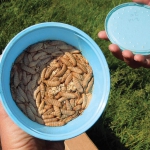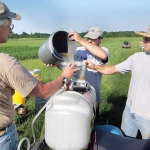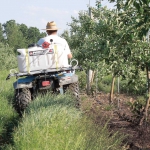New York fruit growers may have found a more effective biocontrol tool for managing plum curculio—and a new model that could be developed and used by growers elsewhere.
The New York method involves seeding orchards with two species of nematodes that are native to the state and are able to survive and thrive year after year.
Cornell University entomologist Dr. Art Agnello says the biocontrol method is not new. Growers can buy, from biological supply houses, the same two species of nematodes, but, past experience shows, they don’t persist more than six months and have to be reapplied every year. But the native strains seem better adapted. One application could populate an orchard indefinitely.
Agnello says fellow Cornell entomologist Dr. Elson Shields laid the groundwork. He was seeking—and found—a biological control for alfalfa snout beetle, which attacks alfalfa crops that dairy farmers use to feed their cows, and he began helping dairymen treat their alfalfa fields.
Shields figured out how to gather a population of native New York nematodes and grow them. Now, he grows them for alfalfa growers and teaches them how to grow their own.
As it turns out, the nematodes that attack alfalfa snout beetle also attack plum curculio, which is a pest of apples, cherries, peaches, and plums, and they attack Japanese beetle as well.
Early field trials in four New York orchard plantings have shown a reduction of up to 70 to 97 percent in the populations of plum
curculio, Agnello said.
Shields is also assisting Cornell entomologist Dr. Greg Loeb and his team, who are investigating the use of nematodes to control grub populations in New York grape vineyards as a way to manage Japanese beetles, which defoliate grapevines.
Key insect
Plum curculio is the bane of apple and stone fruit growers east of the Rocky Mountains, Agnello said, and they routinely spray two or three times shortly after petal fall to control the insect.
Even then, he said, growers will experience damage as high as 3 percent. Most of the damage to apples comes from oviposition stings, but some larvae persist in fruit.
“Apple is not really a great host for plum curculio,” he said. Adult curculio lay eggs in tiny fruit, first making a slit in the apple to insert an egg. If the fruits remain on the tree, the eggs fail to hatch, crushed by the flesh of the growing fruitlet. But the slit leaves a scar that can make the mature fruit unsalable.
After the eggs are laid, many of the infested fruit fall during June drop. In fruits that are on the ground, feeding larvae emerge from the fruit and burrow into the soil, where they complete their life cycle. It is there that they are prey for the soil-dwelling nematodes.
Organic problem
While conventional growers get pretty good control with insecticides, organic growers don’t have many insecticides that are approved and effective. Their main defense has been multiple applications of kaolin clay to act as a physical barrier against the insect. Organic treatment programs can easily range from $150 to $450 per acre per year, and fruit damage often remains at five to 20 percent, Agnello said.
“Although our current work focuses on organic production, conventional apple growers who see plum curculio damage to 2 or 3 percent of their crops in spite of as many as three insecticidal treatments per year will be able to add the use of nematodes to their pest control practices,” he said.
The two nematodes involved are Steinernema carpocapsae and Steinernema feltiae, and together they provide a dual mode of attack.
In an article in the Spring 2014 edition of New York Fruit Quarterly, the Cornell entomologists said that S. carpocapsae attacks adult curculio during the several days the insect spends in the ground after emerging from overwintering diapause. As it moves through the top three inches of the soil, it is ambushed by the nematodes.
S. feltiae hunts for pupae and pre-emergent adults deeper in the soil, tracking them down by sensing their “breath,” emissions of carbon dioxide.
“The use of entomopathogenic nematodes focuses a mortality factor on two vulnerable plum curculio lifecycle windows,” the scientists wrote. “Soil inoculation with native nematode strains persisting for many years provide the economic benefit of a single application suppressing insect populations for multiple seasons. The added benefit of suppressing Japanese beetle larvae within the orchard may also result in a reduction of the adult damage on the tree foliage.”
The majority of current research has been directed toward the inundative release (or “biopesticide approach”), using commercially reared nematode strains, Agnello said. Commercial nematode strains tested under field conditions have not persisted at any effective population level after six months, and the use of these commercial strains would require an annual application.
It may be that the native New York strains are more tolerant of cold weather. They are quite active in early spring, when soils are still cold and the curculio adults are emerging to lay eggs.
In testing, the entomologists selected a young Idared apple planting, an established block of Empire apples, and an organic planting of mixed varieties, all located at a Cornell research farm in Geneva and a commercial orchard in Geneva as establishment sites for long-term entomopathogenic nematode populations. Testing began in 2012.
They are also working on three Hudson Valley growers’ farms with Peter Jentsch, a colleague at Cornell’s Hudson Valley Research Lab in Highland.
The nematodes were reared in a lab colony using wax moth larvae as hosts, which were brought to the field, dissolved and mixed in water in the spray tank, and applied May 30 shortly before sunset in order to avoid excessive sun or heat exposure.
In the short run, Agnello said, fruit growers could get some relief from plum curculio working with the nematodes, since orchards are long-lived and often replanted. Once the land is treated and the nematodes spread, biological control should be ongoing. On the other hand, plum curculio also live outside orchards, and they invade to lay eggs in the fruit.
The nematodes spread slowly but could, ultimately, become widespread in the environment, even outside orchards, reducing the impact of plum curculio and other problem insects, like Japanese beetles, as well. •









Leave A Comment